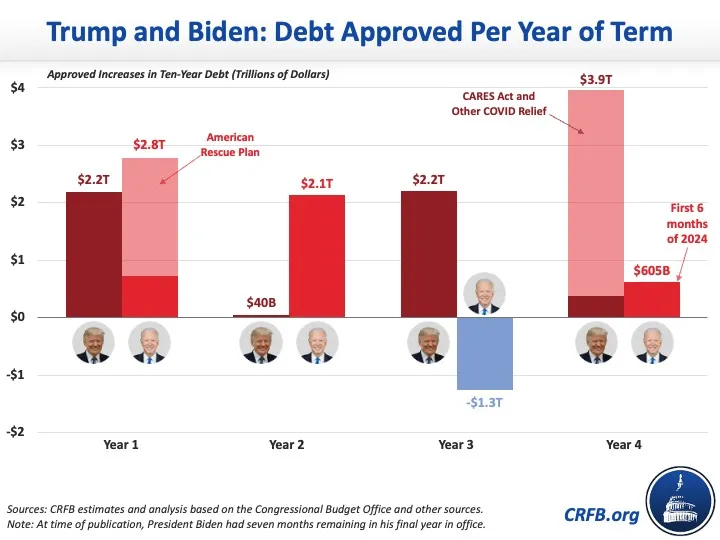Trump and Biden: Timing of New Debt
In a recent analysis, we estimated that President Trump approved $8.4 trillion of new ten-year borrowing during his term in office, while President Biden has approved $4.3 trillion so far in his first three years and five months in office (or $4.8 trillion and $2.2 trillion excluding policies associated with COVID). The timing of this approved debt differs significantly, with the majority of President Trump’s approved borrowing concentrated toward the end of his term and President Biden’s more concentrated toward the beginning.
In this supplemental analysis, we show:
- President Trump approved $2.2 trillion of new ten-year debt in his first two years in office and $6.2 trillion ($2.6 trillion excluding the CARES Act and other COVID relief) in his second two years.
- President Biden approved $4.9 trillion of new ten-year debt ($2.9 trillion excluding the American Rescue Plan) in his first two years in office and has so far approved over $600 billion of net ten-year deficit reduction in the first one year and six months of the second half of his term.
- President Trump’s cumulative approved borrowing was lower than President Biden’s for the first two years and nine months of his term and higher thereafter.
- Much of the difference in timing relates to the COVID-19 pandemic and economic downturn, which began in the final year of President Trump’s term and continued into the first year of President Biden’s term.

US Budget Watch 2024 is a project of the nonpartisan Committee for a Responsible Federal Budget designed to educate the public on the fiscal impact of presidential candidates’ proposals and platforms. Throughout the election, we will issue policy explainers, fact checks, budget scores, and other analyses. We do not support or oppose any candidate for public office.
President Trump approved $8.4 trillion of new ten-year borrowing from 2017 through 2020. He approved $2.2 trillion of borrowing in his first year when he signed the Tax Cuts and Jobs Act into law, $40 billion in his second year when a series of tariffs mostly offset new spending, $2.2 trillion in his third year when he signed into law the Bipartisan Budget Act (BBA) of 2019 and other tax cuts, and $3.9 trillion in his final year when he signed several major COVID relief bills into law.
President Biden has approved $4.3 trillion of new ten-year borrowing from 2021 through June of 2024. He approved $2.8 trillion of borrowing in his first year – largely from the American Rescue Plan, the bipartisan infrastructure law, and other actions – and another $2.1 trillion in in his second year, mainly from appropriations bills, the Honoring Our PACT Act and various executive actions. President Biden approved a net $1.3 trillion of ten-year deficit reduction in his third year thanks to the enactment of the Fiscal Responsibility Act (FRA). And in the first six months of his fourth year so far, he has approved over $600 billion of new ten-year borrowing from additional and supplemental appropriations and a variety of executive actions.
| Trump and Biden: Timing of New Debt (Ten-Year Impact) |

|

|
|---|---|---|
| Year 1 | $2.2 trillion | $2.8 trillion |
| Year 2 | $40 billion | $2.1 trillion |
| Year 3 | $2.2 trillion | -$1.3 trillion |
| Year 4 | $3.9 trillion | $605 billion* (6 months) |
| Total | $8.4 trillion | $4.3 trillion |
Note: Figures may not sum due to rounding.
Source: Committee for a Responsible Federal Budget based on CBO and other sources.
* At time of analysis, President Biden has six months remaining in his fourth year in office.
President Biden approved new borrowing much earlier in his term than President Trump – the American Rescue Plan Act was enacted in March of President Biden’s first year in office while the Tax Cuts and Jobs Act did not pass until December of President Trump’s first year. Although they had approved broadly similar amounts by the end of their first year, President Biden continued to approve new ten-year borrowing throughout his second year. By the midway point of his term, President Biden had approved more than twice as much borrowing as had President Trump at the same point in his term.
By the fourth quarter of his third year in office, President Trump’s level of approved borrowing surpassed President Biden’s due to large bipartisan increases in discretionary spending under President Trump (BBA 2019) and large bipartisan discretionary spending reductions under President Biden (FRA). By the first quarter of his fourth year, President Trump’s total amount of approved borrowing had grown far beyond President Biden’s at that same point, largely as a result of the bipartisan CARES Act and other COVID relief.

Importantly, President Biden still has about half a year left in his term. Beyond that, either President Trump or President Biden will likely be in office for an additional four years, depending on the outcome of the 2024 presidential election. Over this time, they could approve Congressional legislation and/or take other actions to substantially boost or reduce the high and rising national debt.
Read Trump and Biden: The National Debt for more details.
*****
Throughout the 2024 presidential election cycle, US Budget Watch 2024 will bring information and accountability to the campaign by analyzing candidates’ proposals, fact-checking their claims, and scoring the fiscal cost of their agendas.
By injecting an impartial, fact-based approach into the national conversation, US Budget Watch 2024 will help voters better understand the nuances of the candidates’ policy proposals and what they would mean for the country’s economic and fiscal future.
You can find more US Budget Watch 2024 content here.


